Fibroids (aka Uterine fibroids or Leiomyomas) are the most common abnormalities found in the uterus.
What Are Uterine Fibroids
Fibroids (aka uterine fibroids or leiomyomas) are benign (non-cancerous) tumors that come from the muscle layer of the uterus. They usually develop during child-bearing years, with the majority of cases being diagnosed between ages 30-39. These tumors are very common and by the time a woman reaches menopause she has an 80% chance of having developing one. There are three types of fibroids:
- Sub-serosal, which protrudes from the uterus
- Intramural, which is in the muscle of the uterus. These are by far the most common type.
- Submucosal, which are located in the cavity of the uterus.
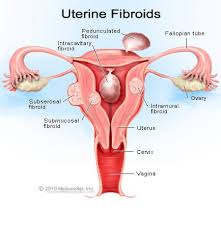
Uterine Fibroids
What Causes Uterine Fibroid
Nobody knows for certain what causes fibroids, though there are quite a few theories:
- Hormones: Because these tumors tend to grow when exposed to hormones, hormonal stimulation is thought to play a part in their growth and formation.
- Genetics: Fibroids are by far more common in African-American women and they also tend to run in families. This means that genetics likely plays a role.
- Diet: Foods like soy, that mimic hormones, are thought to play a role in the development of these tumors.
- Obesity: Obese women produce more of a specific form of estrogen called estrone. Estrone likely stimulates their development and growth.
- Early menarche (onset of menses): Women who start their periods at an earlier age have more overall lifetime hormone exposure which increases their risk for fibroids.
What Are Symptoms of Uterine Fibroids
The good news is that the great majority of women with uterine fibroids have absolutely no symptoms what-so-ever. When symptoms do develop, the most common complaints are:
- Heavy periods (often with clotting).
- Prolonged periods, generally lasting longer than 8 days.
- Spotting or bleeding between periods.
- Painful periods.
- Pelvic pain and/or pressure.
- Pain with intercourse.
- Urinary frequency and leakage of urine.
- Constipation.
- Recurrent miscarriages or problems conceiving.
- Abdominal distension.
- Back pain.
- Anemia due to heavy and/or prolonged periods.
How Are Uterine Fibroids Diagnosed?
Fibroids can usually be diagnosed by your OB/GYN with a simple, in-office pelvic examination. Generally however, a pelvic ultrasound will also be ordered to confirm the diagnosis. Sometimes a special type of ultrasound called a sonohysterogram, may be performed to look inside of the uterine cavity for submucosal fibroids.
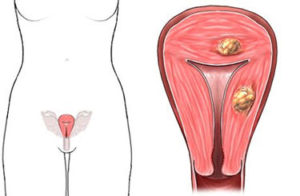
Intramural Fibroids.
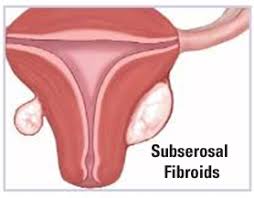
Subserosal Fibroids.
How Do You Treat Fibroids
Remember, up to 80% of women will develop fibroids, so they only need to be treated if they are either symptomatic (see symptoms above) or if they grow rapidly. Very rarely fibroids can become cancerous, an entity known as a leiomyosarcoma, which only occurs in 1 of every 10,000 cases. There are multiple treatment options for uterine fibroids including expectant management, medical management and surgical management.
1). Expectant management is the option of doing nothing at all. If the fibroids are not causing problems, we frequently recommend expectant management since they will shrink after menopause.
2). Medical management includes all of the medications used to treat fibroids. These medications will not cure fibroids but they will reduce their symptoms while hopefully at least slowing their growth:
- Oral Contraceptive Pills (OCPs).
- Depo Provera: An injection given every 3 months that reduces or eliminates periods.
- Mirena IUD: A 5-year intrauterine contraceptive device that is also FDA approved to reduce or eliminates periods.
- Lupron: An injection that mimics the effect of menopause, resulting in reduction of fibroid symptoms and size. Lupron cannot be used long-term because of side effects, but it is a good medication for women close to menopause or for women considering surgery who want to reduce the size of the fibroids allowing a minimally invasive procedure.
3). Surgical management options include:
- Uterine artery embolization (UAE). This is a procedure that reduces the blood supply to the uterus and fibroids, causing them to shrink in size. UAE involves making a small incision in the thigh, threading a device to the uterine artery and injecting embolic agents that block blood flow through the uterine artery.
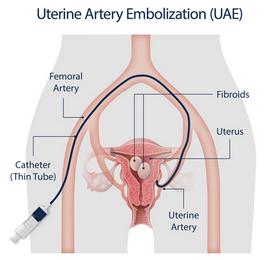
Uterine Artery Embolization.
- Endometrial ablation is an out-patient procedure that cauterizes (burns) the lining of the uterus. It usually takes two minutes or less and can generally be performed in any woman with irregular or heavy periods. While most women who have this procedure stop having periods, patients with fibroids frequently continue to have periods though they are usually much lighter and shorter.
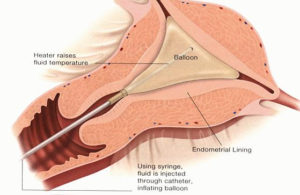
Endometrial Ablation.
- RF fibroid ablation is a procedure that uses radiofrequency waves to reduce the size of fibroids. The procedure requires two small incisions and is done as an outpatient. Over time, they will shrink and are eventually resorbed by the body.
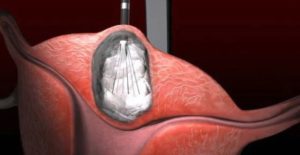
RF Ablation
- Myomectomy involves actually removing the fibroids while leaving the uterus behind. Myomectomy is generally reserved for women who want to preserve the uterus for possible future childbearing. The biggest drawback is that new fibroids can grow after the procedure, the risk is 50/50. Myomectomy can be performed either laparoscopically (a minimally invasive camera surgery with a few small incisions) or by laparotomy (a procedure involving a larger incision, usually a bikini cut).
- Hysterectomy is the most definitive treatment for fibroids. Hysterectomy involves removing the entire uterus along with the fibroids. Depending on age, the ovaries may or may not be removed with the uterus. Regardless of whether or not the ovaries are removed, most doctors are now removing the fallopian tubes since new research indicates that ovarian cancer may actually originate in the fallopian tubes. Hysterectomy may be performed laparoscopically (minimally invasive camera surgery with small incisions) or again by laparotomy (a larger incision, sometimes a bikini cut sometimes an up and down vertical incision).
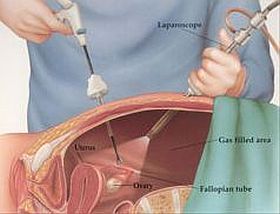
Laparoscopy.
How Can Fibroids Be Prevented?
Because we don’t know what causes fibroids, we cannot definitively tell you how to prevent them. Some things to consider include:
- Exercise: Women who exercise more have been found to have fewer fibroids.
- A diet low in soy since soy mimics estrogen potentially causing fibroids to grow.
- Go organic: Fibroids respond to hormones including the hormones found in foods.
- Consume flavonoids: Citrus, berries, legumes and red wine are all high in flavonoids. Flavonoids have been found to reduce over all estrogen levels.
For more information on benign tumors click HERE
Be sure to check out our website www.TheTwinDoctors.com and please connect with us on all of our social media outlets at TheTwinDoctors.
 May 19, 2018
May 19, 2018
